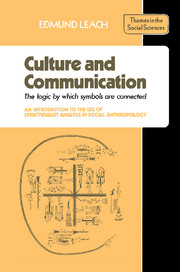 Culture and Communication
Culture and Communication Published online by Cambridge University Press: 05 June 2012
Lévi-Strauss, who has contributed so much to our understanding of meta-linguistic modes of communication, constantly refers to the structural similarity between myth and music. In a celebrated and characteristically opaque statement he has declared that ‘the myth and the musical work are like conductors of an orchestra, whose audience becomes the silent performers’ (Lévi-Strauss, 1970, 17). What on earth can he be talking about?!
At one level he is simply making the point that the senders and receivers of messages which are contained in cultural communication are very often the same people. When we participate in ritual we ‘say’ things to ourselves. But the same sequence of behaviours may mean different things to different people. In general, all Christian sects share the same myths and engage in the same rites, but they disagree passionately about what they mean.
But there is much more to Lévi-Strauss's very complicated musical metaphor than that. A simplified version may help to bring the whole of the foregoing discursive argument into focus.
First let me remind you of the equivalences spelled out at the very end of Section 2. Approximately, though not exactly, Symbol/Sign = Metaphor/Metonymy = Paradigmatic association/Syntagmatic chain = Harmony/Melody. In music, the elements of melody (the individual notes and phrases played in succession) are linked together by metonymy; the relations of harmony, which allow for the transposition of a melodic phrase from one instrument to another, are those of metaphor.
Second, bear in mind the overall purpose of this enquiry. We are trying to understand the process by which information is transmitted between human beings by verbal and non-verbal means in combination.
To save this book to your Kindle, first ensure [email protected] is added to your Approved Personal Document E-mail List under your Personal Document Settings on the Manage Your Content and Devices page of your Amazon account. Then enter the ‘name’ part of your Kindle email address below. Find out more about saving to your Kindle.
Note you can select to save to either the @free.kindle.com or @kindle.com variations. ‘@free.kindle.com’ emails are free but can only be saved to your device when it is connected to wi-fi. ‘@kindle.com’ emails can be delivered even when you are not connected to wi-fi, but note that service fees apply.
Find out more about the Kindle Personal Document Service.
To save content items to your account, please confirm that you agree to abide by our usage policies. If this is the first time you use this feature, you will be asked to authorise Cambridge Core to connect with your account. Find out more about saving content to Dropbox.
To save content items to your account, please confirm that you agree to abide by our usage policies. If this is the first time you use this feature, you will be asked to authorise Cambridge Core to connect with your account. Find out more about saving content to Google Drive.